Samsung Galaxy Note 3 Review
by Brian Klug on October 1, 2013 9:00 AM EST- Posted in
- Smartphones
- Samsung
- Mobile
- Android 4.3
- galaxy note 3
Cellular and WiFi
With the advent of MSM8974 comes the third generation of Qualcomm’s LTE modem, in this case what 8974 brings over the second generation is new Category 4 LTE (up to 150 Mbps on the downlink) over the previous generation’s Category 3 maximum, 3GPP release 10 carrier aggregation, up to 3 carriers of HSPA+ aggregated, and of course the requisite CDMA 1xAdvanced/EVDO, GSM/GPRS/EDGE.
Of course it’s up to each operator and handset maker to make their own decision regarding what features they want implemented via the choice of frontend RF components, and in the case of the Note 3 those insights will really have to wait until someone tears one down. I suspect however that with the Note 3 Samsung marches even closer to a single worldwide SKU or at least fewer SKUs for each region. In the case of the T-Mobile Note 3, there’s disclosure for the banding that I would expect in the FCC documents, Bands 2, 4, 5, and 17 LTE are supported, at minimum, I wouldn’t be surprised to see 7 and 20 also supported in the same hardware. I strongly suspect we’re looking at a situation similar to the SGS4 where there was shared platform and front end between AT&T, T-Mobile, and Canada. I haven’t had time however to go through and look at all the Note 3 variants and their banding, and as usual Samsung doesn’t disclose their band combinations up front.
Without 20 MHz FDD LTE to test on T-Mobile, there’s not much we can really say about Category 4 in the context of the Note 3 review. In other markets with 20 MHz FDD LTE however this will open up additional throughput headroom that some already are up against.
The Note 3 continues to have Samsung’s great ServiceMode option for looking at signal characteristics like RSRP, channel bandwidth, and forcing whatever bands you want. However Samsung did remove the unlock shortcuts that were popularized for the previous Galaxy S series and Notes through the debugging screens and phone control menu. This also happens at the same time Samsung has started region locking devices.
As devices move closer to being truly universal with more LTE bands, I wouldn’t be surprised to see more of this kind of arbitrary locking being used to keep operator verticals in place and protect markets.
I had no issues with the Note 3 in both 5 MHz FDD LTE markets like NYC where I did some of my testing, and my home market in Arizona which is 10 MHz FDD LTE on T-Mobile.
Antenna placement on the Note 3 is pretty pragmatic as well, at least on this variant. One big main antenna for transmit on all the bands supported by the hardware, and a second diversity antenna for LTE and WCDMA.
A big new thing in the Note 3 is the inclusion of a component from Qualcomm’s RF360 portfolio, the QFE1100 envelope power tracker, making it the first device to do so. This reduces overall thermal footprint and power consumption on the RF front end by varying the voltage across the power amplifier (which previously was a fixed DC voltage) to match the waveform of the transmitted signal. The envelope tracker essentially is a power supply with a closed loop between the baseband and the power amplifier, which enables the power amplifier to closely follow the desired transmitted waveform. Envelope trackers help mitigate the power waste that comes with high peak to average power ratio inherent to OFDMA (LTE) by closely matching the power amplifier voltage supply to the output signal. This allows the power amplifier to work much closer to the peak of its power added efficiency (PAE) curve, especially when the input signal envelope is low, by tracking the amplitude of the input signal.
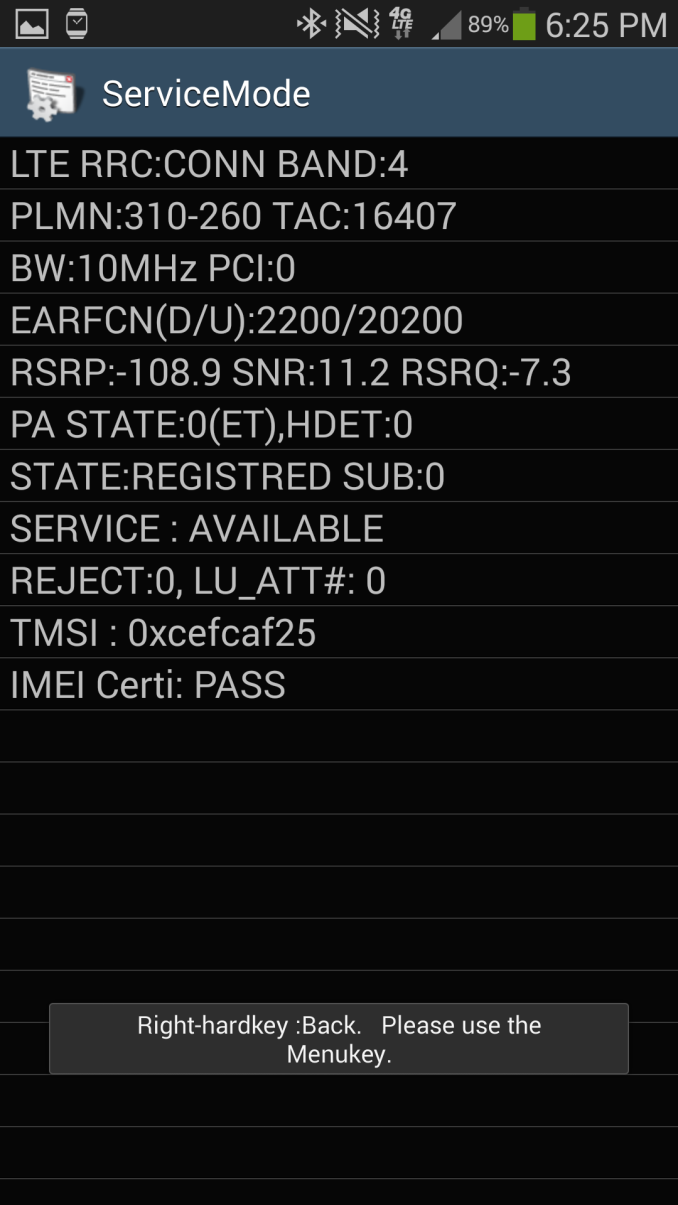
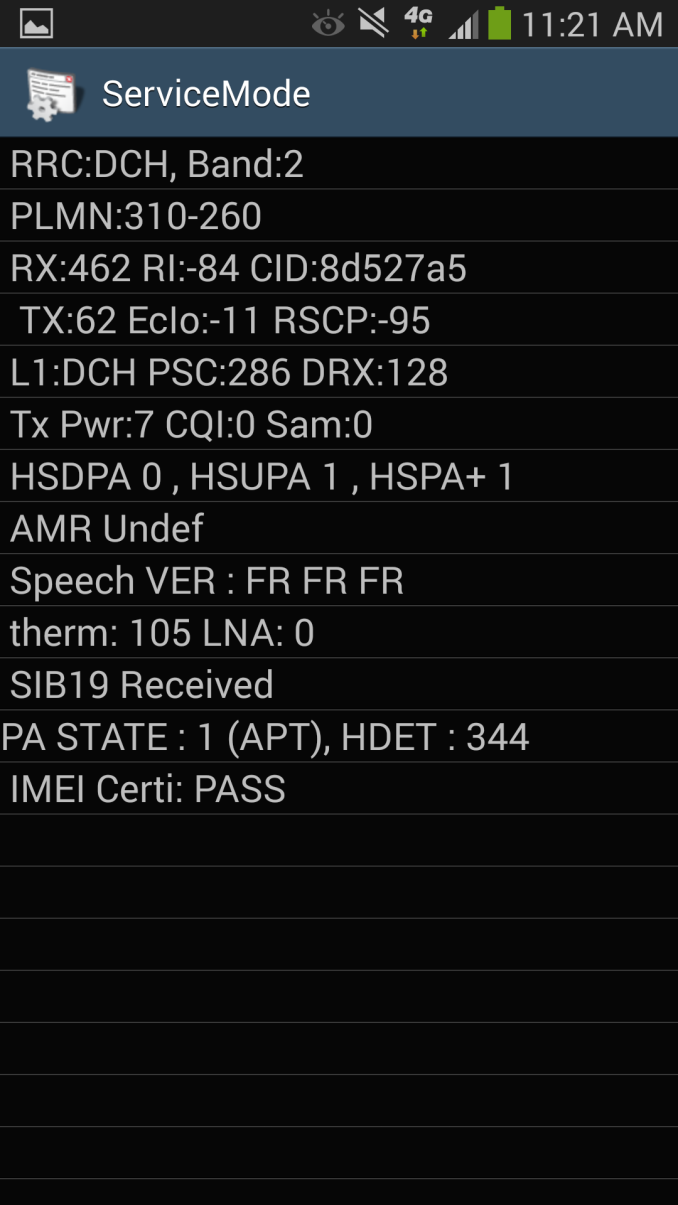
ET (Envelope Tracking), and APT (Average Power Tracking) on Note 3
Watching ServiceMode on the Note 3 is a real treat since you can see PA State change between a few different modes, APT/PT/ET which I suspect translate to average power tracking, power tracking, and envelope tracking modes, again confirming the presence of the power tracker. Qualcomm has a post up about the QFE1100 and its use in the Note 3.
GNSS
With 8974 also comes another newer version of Qualcomm’s GNSS (Global Navigation Satellite System) software suite. The previous generation (GNSS Gen 8/8A) included support for GPS and Russia’s GLONASS system. The new one onboard 8974 and forward moves to GNSS 8B which includes support for GPS, GLONASS, and China’s Beidou constellation.
At present there’s no way for me to validate whether Beidou support is working on any of the 8974 phones I have, because the coverage for that constellation is not global but rather limited to a slice in the Asia-Pacific region. I’m not aware of any other improvements inside GNSS 8B, but Qualcomm’s GNSS has always been excellent for me, locking quickly even indoors or in urban canyon scenarios. The Note 3 performs very well and locks quickly and I don’t have any issues to speak of.
WiFi
I didn’t expect much to change on the Note 3 from SGS4 in terms of WiFi connectivity, but I got an interesting surprise. Instead of the BCM4335 combo which was ubiquitous in this last round for WiFi/BT/FM radio, there’s the newer generation BCM4339 combo which integrates the necessary power amplifiers and front end components for a lower cost solution.
BCM4339 is still a single spatial stream part with support for 802.11a/b/g/n/ac, and on 802.11ac support for up to 80 MHz channels with 256QAM under MCS9, for a PHY rate of 433.3 Mbps, which is what we’ve seen before with 4335. Again what’s new is the integration of the 2.4 and 5 GHz power amplifiers for transmit and low noise amplifiers the receive chain, as well as the other necessary front end components, although handset makers can still choose to support their own external ones. This drives integration cost down and hopefully means 802.11ac will find its way into more places.
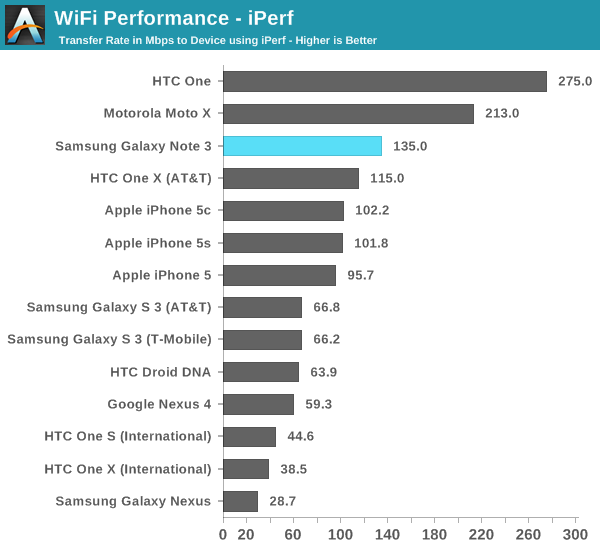
I tested the Note 3 using iPerf the same way I have other phones for a while now and saw some weird behavior. WiFi throughput during my test jumped around quite a bit and even on the 433 Mbps PHY rate the maximum sustained rate I could get was around 135 Mbps. Still very fast, but not quite up as high as some of the other 802.11ac phones I’ve tested.
I don’t like that there’s no band preferences option under the advanced menu anymore, although this seems to be a thing operators want removed (which makes no sense to me, but whatever). The Note 3 does add an auto network switch toggle which seems to be a feature Qualcomm has added to its BSP lately to allow for intelligent switching between WiFi and cellular when the WiFi network you’re attached to isn’t delivering any packets. I also noticed that the Note 3 will shut down the data session for cellular when you’re attached to WiFi as well to cut down on power use, something a few other vendors have done for a while.
Speaker and Noise Rejection
With the Note 3, Samsung changes up the normal speakerphone location dramatically, from the back side coming out of the battery cover to a new place blasting out the bottom lip of the Note 3 through a grille. I tested speakerphone on the Note 3 the same way I have other devices, by placing a call, cranking volume up to maximum, and using a data logging sound pressure meter to record and average the entire call.
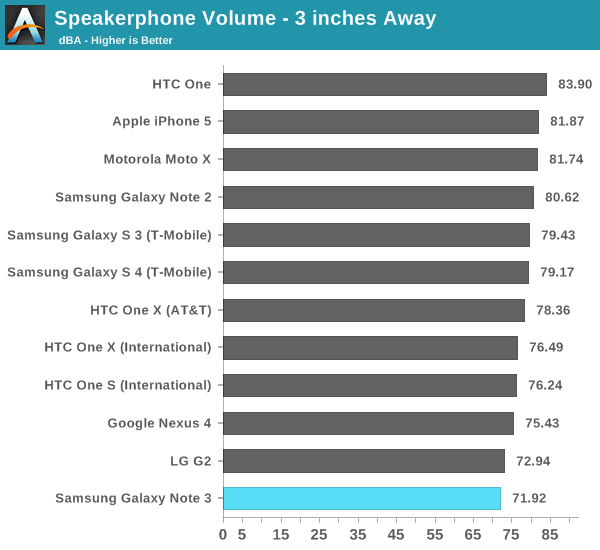
Oddly enough, speakerphone is very quiet on the Note 3 and isn’t nearly as loud as SGS4. More puzzling, tapping the extra volume button doesn’t seem to do anything at all if you’re attached to WiFi, however the button works if you’re not attached to WiFi (and thus the background data connection is enabled). This seems like a bug to me, as it’s very quiet compared to the competition, and unfortunate since part of the Note 3 is that expectation of a great multimedia experience with the big display.
A big change in the Note 3 is the inclusion of a new generation of Audience voice processor, the Audience eS325 which we’ve talked about before, which includes support for using three microphones for ambient noise reduction. Interestingly it turns out the SGS4 had 3 microphones and this same solution, but only ever used them in pairs (the third was next to the earpiece and only used during speakerphone calls). The Note 3 has three very visible microphones, one at top, one at bottom, one on the bottom right side.
Audience enables noise reduction on narrowband (8kHz), wideband(16kHz), and super wideband (24kHz) calls with this new generation with the three microphones. This new solution also adds de-reverb which helps reduce the reflections audible when calling from an enclosed room, something the previous generation didn’t have.
To test I ran through the same test we’ve done in the past, I speak into the handset in front of speakers playing a babble distractor track up to a certain sound pressure level, and then back down. I added in a speakerphone mode (far talk) mode as well just for comparisons, with the noise reduction toggle that Samsung makes available in the phone dialer toggled on and off, for comparisons. I called between a T-Mobile Galaxy S 4 and the Note 3 on T-Mobile, which gave us 12.65 kbps AMR-WB (“HD Voice”) voice call, in a spectogram of the recording we can also see components above the 4 kHz filter for a normal narrowband voice call (narrowband is again 8 kHz sampling, AMR-WB uses 16 kHz sampling, after nyquist we pass 4 kHz and 8 kHz respectively).
The eS325 does a good job rejecting the babble track without rejecting a lot of the incoming voice or making me sound distorted. I’m always impressed that anything is audible at the maximum volumes as these are literally so loud I can’t hear myself talking into the handset and probably not conditions normal people would call under anyways. Noise rejection on these larger phablet or Note sized phones is also a challenge since the microphone pairs are far apart and the mouth is physically further from the microphones than they normally would be, so I’m impressed with overall performance considering those constraints.


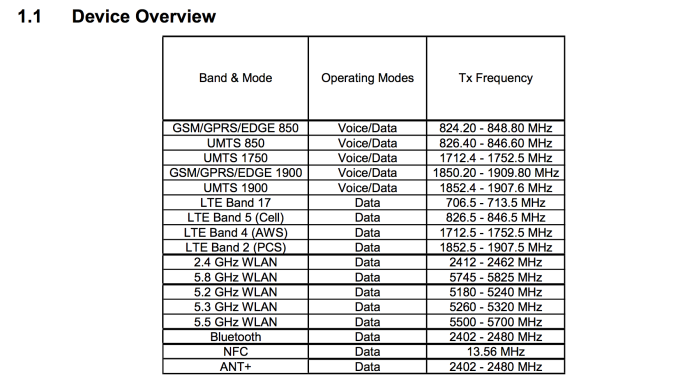
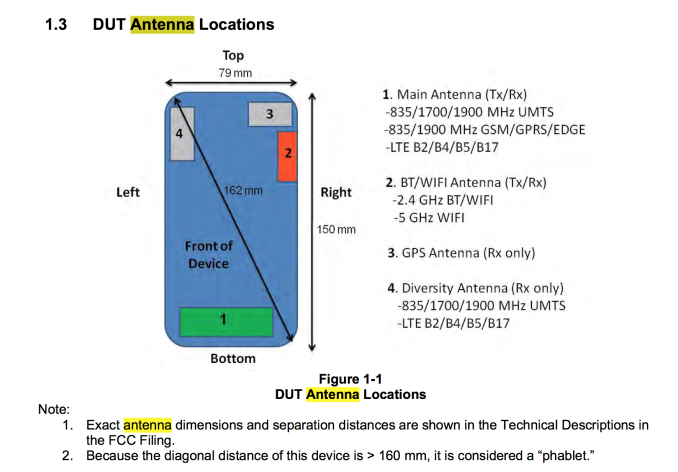
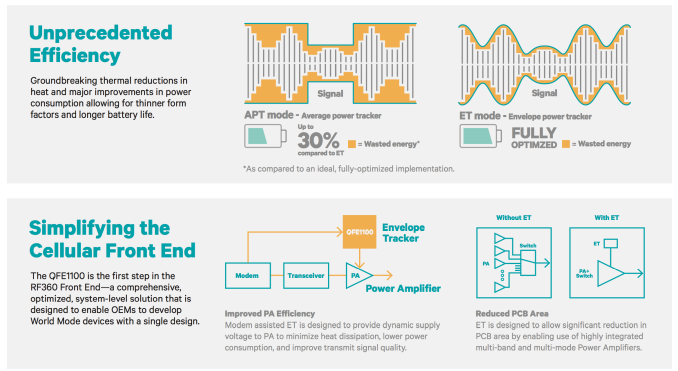
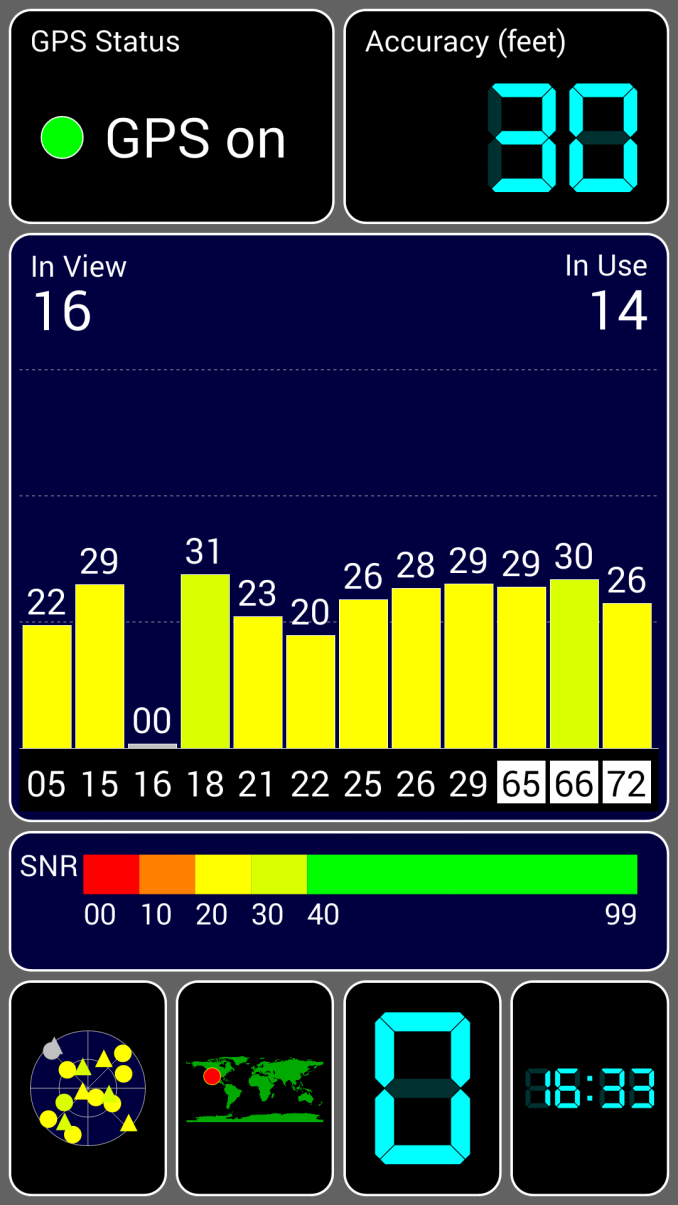

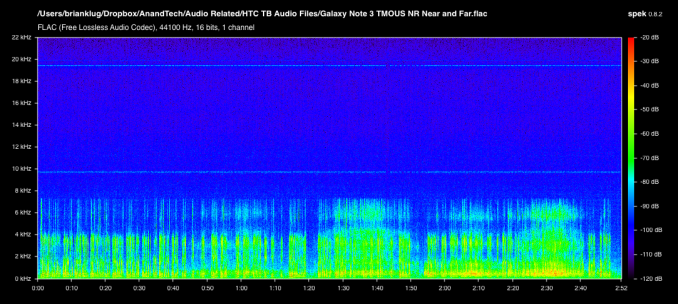








302 Comments
View All Comments
barry spock - Tuesday, October 1, 2013 - link
I don't usually bother to comment here but I agree with the above comment. It doesn't matter if it's samsung or android that's playing funny buggers. The fact that the benchmarks are being tampered with it should be clearly stated in every review involved.Spunjji - Tuesday, October 8, 2013 - link
It was. Several times. Your comment is *utterly* pointless.bigpics - Wednesday, October 2, 2013 - link
Actually thanks to Anand Lal Shimpi and Brian Klug on this site we do know that it's almost everyone in Android world who matters at least (the article mentions LG, Asus and HTC): http://appleinsider.com/articles/13/10/02/asus-htc...As for others, the AppleInsider article quotes Andandtech as saying, "With the exception of Apple and Motorola literally every single OEM we’ve worked with ships (or has shipped) at least one device" that similarly fudges benchmarks."
That being said, I think it should be CLEARLY pointed out in every review of every such device if unfudgeable benchmarks can't be easily created (or until they are).
ESC2000 - Sunday, October 6, 2013 - link
In addition to running the benchmarks, Brian also commented extensively on his real world experience using the phone. So instead of getting your panties in a twist about unscrupulous approaches to benchmarks, why don't you focus on the real world performance that is much more informative and not affected by the benchmark issues? I'm betting that most of the panty-twisted people don't even use Samsung products but just feel the need to take them down a notch.Geronemo3 - Thursday, October 24, 2013 - link
He called it cheating more than a few times. Yes manufactures should stop this stupidity. Plus the benchmarks are for reference and we can maybe minus 10% performance from it. I don't remember the last time I purchased a smartphone just on benchmarks alone.Aenean144 - Tuesday, October 1, 2013 - link
Anand,As soon as you published the benchmark charts with the Note 3 sitting at the top, as the highest performant Android device, you've willingly assisted in Samsung's aims with their benchmark boosting processes. This is their goal. Even though you mention it in words, it's the charts that are important as the charts are linked and displayed far and wide across the Internet. The words will be quickly forgotten or are just unread as is typical in the attention deficit addled Internet.
It's unfair to the LG G2, the Sony Z1, likely to the Nexus 5, and to any other Snapdragon S800 device out there that don't employ the same tactics. There's no magic to Samsung's use of the S800 here. It should perform about the same as any other S800 device.
But by publishing the charts as you did in this review, you are being nothing but a sop to Samsung. Call it what it is. Cheating. Don't publish the benchmark comparison charts if you *know* that Samsung is cheating. Don't publish the charts if you know that others are cheating. Your customers are your readers, not Samsung, not LG, not Qualcomm, not Apple or whoever.
uvaman20 - Tuesday, October 1, 2013 - link
Aenean144 and others,I don't care about Samsung and their cheating and if Anandtech didnt bring the story YOU and prolly 98% of the people on the Earth wouldn't know about this so stop blaming them. Blame Engadet, Phonearena, GSMarena and others for that...They presented the idea and they published that (even they knew that Samsung will be pissed). We know they are "cheating" now and LIVE WITH THAT. Its the same shit with with car manufactures and consumption? Ask them why they cheating and go that long that you dont want to buy cheating car and I can bet you did... Look at browser games, they are all cheating and? Government is cheating us on a daily base and what we did? We know to Whine only...
Aenean144 - Tuesday, October 1, 2013 - link
Nobody here is blaming Anandtech. We're trying to push them to up their game, be consumer advocates, and not try to be a mouthpiece for these companies. Report the truth.Btw, it wasn't Anandtech that revealed the SGS4 benchmark boosting business. It was some dude working on SGS4 overclocking and who reported it on Beyond3D forums. Anandtech let it sit for month. It was Anandtech who made it part of the news cycle demonstrating the power of their platform. Now for the Note 3, it's Ars Technica who've really done the best benchmarking; while it seems that Anandtech is playing footsie with Samsung.
At times, Anandtech is entirely too politic about it. Call it what it is. If they want it to stop, call it what it is. Playing nicely or doing stuff behind the scenes isn't doing consumers any favors. If they see there are problems, run application benchmarks, look a video transcode.
dugbug - Tuesday, October 1, 2013 - link
Anand, why don't you just do what ARS did and attempt to create renamed benchmarks that sidestep their silly string matching game.vFunct - Tuesday, October 1, 2013 - link
Are you implying that Apple uses benchmark cheats like Samsung does?